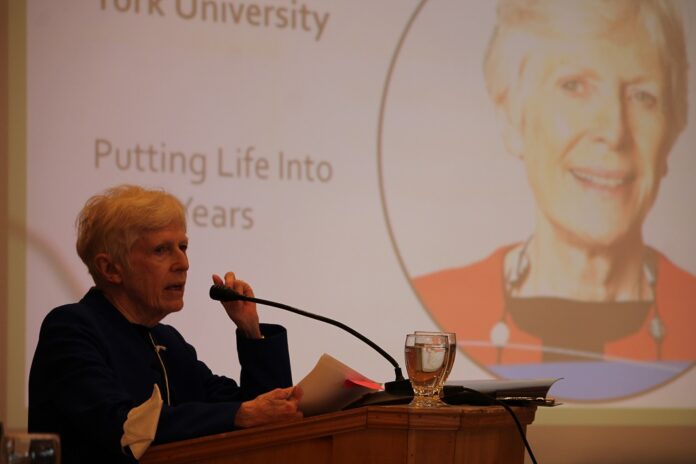During her keynote address to the Aging Together as Community conference in Haliburton County Jan. 27, Dr. Pat Armstrong talked about putting life into years, versus putting years into life.
More than 150 people attended the conference at the Pinestone Resort and Conference Centre, learning about an Indigenous perspective on elder care, projects at Hyland Crest, and Rotaract’s intergenerational perspectives, to name a few, under the theme of inspiring creativity, empowering change.
Armstrong is a long-term care research professor at York University. She headed up a research study of LTC in Norway, Sweden, the U.K., U.S. Germany and Canada.
She referenced a German LTC home, whose manager said, “our purpose is to put life into years, not simply years into life… and we would add this includes opportunities for joy for those living in, working in and visiting LTC homes.”
Armstrong said LTC homes in Canada, and particularly Ontario, do not do a good job of either. She referenced the Canadian military finding terrible conditions during COVID. She said many Canadians think LTC is “the last and worst resort.”
However, she said family members in Sweden and Germany do not feel guilty when they put loved ones into LTC, while a significant number of Swedish seniors would prefer going into nursing homes, even if offered significant home care.
In Ontario, she said people say there are pros to LTC homes, such as their loved ones having company, being safe, such as getting medications, having access to activities, such as bingo, and care for meals and laundry.
But to bring joy, she said homes must be properly staffed. She said staffing levels in Sweden are more than twice Canada. She said staff have the time to chat and get to know residents; get them to walk versus putting them in wheelchairs. She said family do not have to fill gaps for survival. The only thing families have to do is socialize. Staff continuity is key, she said, so residents know the workers. In Ontario, there are a lot of part-time, and casual staff “without proper training.”
The researcher added when there are scandals, the result is more regulations, leading to “robotic care.”
She said in a Norwegian LTC, staff had coffee during shift changes to talk about issues and strategies, supporting each other and providing better care. She noted how one home integrated music into everyday life. When someone was admitted, staff copied their music and printed out words. They had a resident choir. “There was a sense of belonging and joy for residents and staff.” She said some do art exhibits, and a home in Toronto was planning to do drive-in wheelchair movies.
Other examples were bringing joy to eating. She said one LTC home chef in the U.K. noticed residents were not eating much because they were overwhelmed with the amount of food, so he made appetizer sized portions handed out on trays.
Laundry was also important to residents, Armstrong said. She noted there are crisis when clothes are lost, shrunk, or a resident is found wearing another’s clothes. In Sweden, she said rooms have small washers and dryers in them.
She added so many homes are fearful of risk, they deny residents joy – such as walking versus a wheelchair, eating ice cream and even drinking small amounts of alcohol.
“We have to balance the risk against what is being lost and denied.”
She added residents want to be where the action is, not put out to pasture. In Norway, she said they visited a complex that housed a nursing home, swimming pool, theatre, restaurant, spa, and child care centre, a “hub of activity.”
Bonnie Roe, of the steering committee, said the conference was, “a very full day, filled with inspiration, creative ways of supporting our aging population and opportunities for conversation with people throughout the County.
“We need their voices, and voices from all ages, to be the catalyst for change to improve the aging experience for all.”





